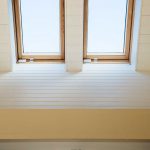The simplest stairs are made from timber or steel. These can be assembled in a day and only take up a small amount of floor space. Spiral staircases start from around £1000/€1,330.
In ROI the Building Regulations aren’t crystal clear when dealing with staircases providing access to the roof space, but to be on the safe side, if the space is habitable then standard Building Regulations should apply, which means a maximum angle of 42° and a minimum of 2m of clear headroom above the pitch line on your staircase (i.e. a measurement taken vertically from every step must show a headroom clearance of 2m). The headroom requirement is 1.9m in the roof space. If this space will only be used for storage then it’s often assumed the Regulations don’t apply and you could then allow for a steeper flight of stairs.
Spacesaver stairs are an option for loft conversions, whereby alternate treads take up about half the space of a standard flight; they are particularly useful in conversions where tightness of space is often a major problem. They should really only be used for access to one habitable room plus bathroom or wc providing it is not the only one in the house.
These units can be bought as DIY flat packs or pre-assembled units, with the minimum 220mm going set out in Building Regulations (NI & ROI). The rise height is then adjusted to suit your floor levels. The well opening on the upper level should be at least 1.5m long and the width of the staircase. This type of staircase is not ideal for the elderly or young children but may be the only solution in some cases. To overcome the problem of light, it’s possible to specify steel rods rather than solid risers on these staircases – these reduce the opening gap to less than 100mm, as required by Building Regulations. In NI your planning officer may allow a spacesaver to have a steeper pitch of up to 54° instead of the more usual 42°, but this will be at their discretion as the Regulations do specify 42° for access to the attic.
If fitting a staircase under a roof pitch, check the headroom and avoid placing underfloor heating pipes below the plan footprint of the staircase as fixings will need to be put into the floor structure.
It’s worth taking some time over this as any mistakes could turn out to be very costly. There are a number of points to remember:
- A stairway takes a great bite out of the space on both floors.
- The Regulations governing stairways are strict.
- Avoid making the mistake of bringing the stairway out under the eaves where there is insufficient headroom. The best approach is to think about the stairs and the dormer or dormers together, and keep experimenting until you have the best all-round solution.
Impact on services
Plumbing Water pipes, cisterns etc. are fairly easily re-routed; regard the work as an opportunity to update any worn components. If any taps or wc’s are to be fed from a cold water cistern, this too will have to be raised above the roof space floor and the water kept cool to prevent bacteria multiplying. In ROI the water tank is placed outside the insulated area of the house which works if the weather is cool, but even in Ireland we sometimes get heat waves. Because of this, it is better to fully insulate the tank so that the water temperature can be kept as steady as possible.
The alternative is a pressurised system for which you will need a plumber who is familiar with installing these. If you want to have a bathroom or shower in the space, with no need for storage tanks, this is the preferred option. Waste or ‘foul’ water from bathrooms must be safely removed, with any soiled vent pipes placed well away from windows.
Heating By increasing the floor space of the house there will be extra demand for central heating. If yours is a ‘wet’ system, check that your existing central heating pump is equal to the task of coping with the new rooms – there’s no point in adding radiators if they won’t work because the system can’t cater for the extra demand. Remember that the feed and expansion tank will have to be positioned above the level of the radiators and this is unlikely to be the case in the attic so airlocks could easily develop. You can solve this problem by pressurising the heating system.
The good news is if the house is very well insulated, you may not have created much of an extra demand for energy!
If building a dormer or raising the roof, this could be an opportunity to put in solar collectors which may be quite cost effective. By including the cost (€4,500 – 6,000/£3 – 4,000) of the solar panels within a mortgage to be paid back over 20 years, it could prove to be an excellent investment. You might also take the opportunity to further improve your home’s energy rating by increasing the insulation in the roof, and thus reducing the overall heat loss. This will help to compensate for the parts of the building you can’t upgrade.
Note that unused chimneys can often be demolished, but any flues remaining may have to be encased to satisfy building control. However, ventilation pipes and ducting can usually be moved relatively easily.






